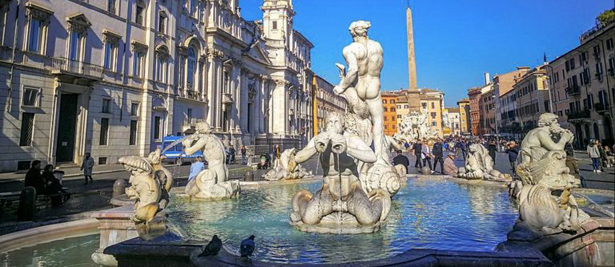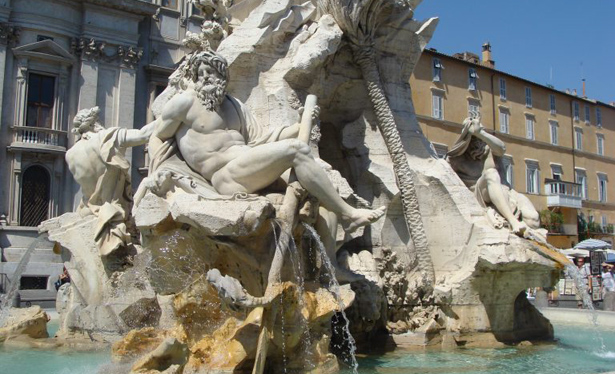Rome City Walking Guided Tour

ROME WALKING TOUR
The tour Itinerary
Un unforgettable walking tour to visit Rome squares and most fascinating corners of the Eternal City. The tour includes Campo dei Fiori with its characteristic markets, Navona Square decorated with the Bernini's fountain of the Four Rivers, the Pantheon (inside visit), the Trevi Fountain and Piazza di Spagna.
TOUR DETAILS: Discovering Rome!
Language: English
Availability: every day. From November to the end of March this tour is available on Tuesday, Thursday and Saturday.
Tour starting Time: 9:30 am
Price: 35,00 euro per person
Duration: about 3 hours
Price includes: guide service for 3 hours, headphones
Children: free under 4 years of age, from 4 to 12 years children pay reduced price ticket 28,00 euro.
Meeting point: Largo Argentina 52, in front of the Argentina Theatre (Teatro Argentina), 15 minutes before the tour starting time, that is at 9:15 am.
Fontana dei Quattro Fiumi and Navona Square

The Fontana dei Quattro Fiumi by Bernini
Built for pope Innocent X Pamphilj, this magnificent fountain in the centre of Piazza Navona was unveiled in 1651. The pope’s coat of arms, the dove and the olive branch, decorate the pyramid rock formation supporting the Roman obelisk, which once stood in the Circus of Maxentius on the appian Way. Bernini designed the fountain, which was paid for by means of taxes on bread and other staples.
The great rivers – the Ganges, the Danube, the Nile and the River Plate – are represented by four giants. The Nile’s veiled head symbolizes the river’s unknown source, but there is also a legend that the veil the conveys Bernini’s dislike for the nearby Sant’Agnese in Agone, designed by his rival Borromini. Similarly, the athletic figure of the River Plate, cringing with arm upraised, is supposed to express Bernini’s fear that the church will collapse. Sadly, these widely believed stories can have no basis in fact: Bernini had completed the fountain before Borromini started work on the church.
Piazza Navona in Rome
Rome’s most beautiful Baroque piazza follows the shape of Domitian’s Stadium which once stood on this site – some of its arches are still visible below the church of Sant’Agnese in Agone. The agones were athletic contests held in the 1st-century stadium, which could seat 33,000 people. The word “Navona” is thought to be a corruption of in agone. The piazza’s appearance and atmosphere were created in the 17th century with the addition of the Fontana dei Quattro Fiumi. The other fountains date from the previous century but have been altered several times since. The basin of the Fontana di Nettuno, at the northern end, was built by Giacomo della Porta in 1576, while the statues of Neptune and the Nereids date from the 19th century. The Fontana del Moro, at the southern end, was also designed by della Porta, though Bernini altered it later, adding a statue of a Moor fighting a dolphin. Up until the 19th century, Piazza Navona was flooded during August by stopping the fountain outlets. The rich would splash around in carriages, while street urchins paddled after them. Today, with its numerous shops and cafés, the piazza is a favourite in all seasons. In summer it is busy with street entertainers, while in winter it fills with colourful stalls selling toys and sweets for the feast of the Befana.
The Pantheon

The Pantheon in Rome
In the Middle Ages the Pantheon, the Roman temple of “all the gods”, became a church; in time this magnificent building with its awe-inspiring domed interior became a symbol of Rome itself. The rectangular portico screens the vast hemispherical dome: only from inside can its true scale and beauty be appreciated.
The rotunda’s height and diameter are equal: 43,3 m (142 ft). The hole at the top of the dome, the oculus, provides the only light. We owe this marvel of Roman engineering to the emperor Hadrian, who designed it (AD 118-125) to replace an earlier temple built by Marcus Agrippa, son-in-law of Augustus. The shrines that now line the wall of the Pantheon range from the Tomb of Raphael to those of the kings of modern italy.
The tour Itinerary: Rome city walking tour
Un unforgettable walking tour to visit Rome squares and most fascinating cornes of the Eternal City. The tour includes Campo dei Fiori with its characteristic markets, Navona Square decorated with the Bern in's fountain of the Four Rivers, the Pantheon (inside visit), the Trevi Fountain and Piazza di Spagna.









